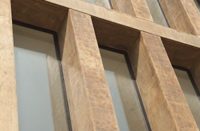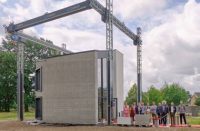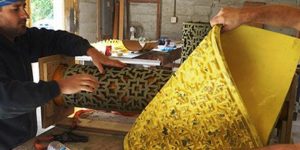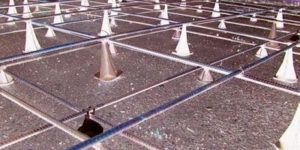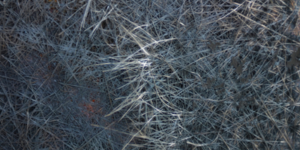Fiber reinforcement protects concrete. It minimizes cracking as the concrete dries and it helps hold the concrete together if cracks develop after the concrete has hardened. Fibers are also available for decorative concrete.
Fiber reinforcement protects concrete in two ways. Mainly, it minimizes cracking from plastic shrinkage that occurs as the concrete dries during the first 24 hours after placement. Also, it helps hold the concrete together if cracks develop after the concrete has hardened. Several types of fibers are available for decorative concrete applications.
Polypropylene
Sandy Stewart, marketing manager for Propex Concrete Systems, recommends her company’s Fibermesh 150 product. “It’s a microsynthetic monofilament, or single-strand, fiber,” she says. “The reason you would use a monofilament fiber is for finishing and aesthetics.”
The fibers are compatible with regular finishing techniques, and any fibers that might appear on the surface would be worn away by foot or vehicle traffic, according to Propex brochures. Typically applied at a rate of 1 pound per cubic yard of concrete, Fibermesh prevents 80 to 100 percent of all plastic-state cracks. The company’s patented e3 technology produces varying lengths and thicknesses of fibers. Stewart says this helps distribute the fibers throughout the concrete, much like graded aggregate improves distribution.
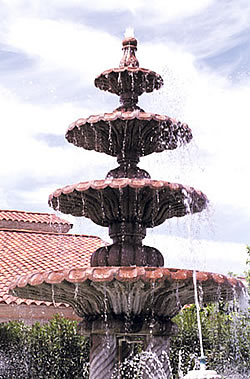 “Our fiber is a mechanical aid,” says Don Smith, senior corporate technical advisor for Propex. “We don’t disrupt or change hydration, or affect many of the other hardened concrete properties.” The fibers have been used in many kinds of decorative work, including stamped, patterned and colored concrete, plus overlays and toppings. Smith says polypropylene doesn’t react with acids that are typically used for cleaning or staining concrete. And although he is not aware of a project using the fibers in stenciling, Smith believes there would be no problem with that application. “Our fibers wouldn’t do anything to interrupt concrete-to-concrete bonds,” he says.
“Our fiber is a mechanical aid,” says Don Smith, senior corporate technical advisor for Propex. “We don’t disrupt or change hydration, or affect many of the other hardened concrete properties.” The fibers have been used in many kinds of decorative work, including stamped, patterned and colored concrete, plus overlays and toppings. Smith says polypropylene doesn’t react with acids that are typically used for cleaning or staining concrete. And although he is not aware of a project using the fibers in stenciling, Smith believes there would be no problem with that application. “Our fibers wouldn’t do anything to interrupt concrete-to-concrete bonds,” he says.
Fibermesh is sold in water-soluble bags that can be tossed directly into the concrete while it’s being mixed, either at the plant or at the job site. “It’s easier if they’re added at the plant,” Stewart says. “We sell through ready-mix companies, so if someone’s ordering concrete, they just order it with the fibers.” She said the cost varies across the country, but that it is small in comparison to the concrete it will protect.
Nylon
Nycon Inc. manufactures a variety of concrete reinforcing fibers, but for use in decorative concrete, Nycon president Bob Cruso generally recommends nylon fiber products. “The nylon fibers don’t leave any residual fiber on the surface, so you can actually finish it as you would plain concrete,” he says. “You have to take more care with a polypropylene-type fiber. You have to be sure the concrete’s not too wet, because then you may have fibers coming to the surface and balling up while you’re brooming or troweling it.”
One reason nylon fibers don’t rise to the surface during finishing is that they absorb water. This moisture gain enhances hydration of the cement particles that are adjacent to the individual fibers, increasing the bond between the mortar and the fiber. As a result, the mortar encapsulates the fibers, keeping them from being exposed during finishing. Another factor that makes nylon fibers less likely to float to the surface is that their specific gravity is 1.16, compared with 0.91 for polypropylene fibers.
Nylon fibers absorb coloring added to concrete, and acid staining doesn’t damage the fibers. “The acid stain is going to be on the surface, and the fiber will be just below the surface,” Cruso says.
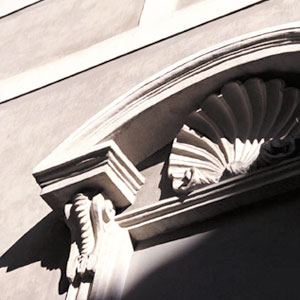 Unlike polypropylene, nylon fibers are resistant to ultraviolet (UV) light. “Fibers are there to stop the cracking, but if a crack does occur, they’re there to hold the concrete together after it cracks,” Cruso says. If cracks occur, sunlight can penetrate through them and reach subsurface fibers. Nycon literature reports that after 500 hours of UV exposure, nylon retains 95 percent of its breaking strength, but polypropylene retains only 2 percent of its strength.
Unlike polypropylene, nylon fibers are resistant to ultraviolet (UV) light. “Fibers are there to stop the cracking, but if a crack does occur, they’re there to hold the concrete together after it cracks,” Cruso says. If cracks occur, sunlight can penetrate through them and reach subsurface fibers. Nycon literature reports that after 500 hours of UV exposure, nylon retains 95 percent of its breaking strength, but polypropylene retains only 2 percent of its strength.
Cruso cautions against adding the fibers at the job site. “Ready-mixers are the manufacturer of the concrete product. If you start adding ingredients to the ready-mix truck on the job site, you may lose any warranty that might be available from the ready-mix producer.”
The application rate for nylon fibers is typically about 1 pound per cubic yard of concrete. “Depending on the market and what part of the country you’re in, the fibers would add somewhere in the range of $5 to $10 per cubic yard,” Cruso says.
Nylon fibers are somewhat more expensive than polypropylene. For instance, Concrete Fibers Inc., another manufacturer, charges 25 percent more for its nylon fibers than for its polypropylene product.
Fiberglass
Nycon also produces glass fibers, which company literature says are used to “enhance the life span and serviceability of concrete flatwork, precast products (and) architectural/decorative surfaces.” However, Cruso generally does not recommend them for decorative concrete. “Because it’s a stiffer fiber, it has a tendency to stick up through the surface,” he says, “whereas the nylon doesn’t do that because it’s a much more pliable material.”
Steel
Fibercon International manufactures steel reinforcing fibers for concrete. Its literature says adding steel fibers increases the flexural strength of mortar or portland cement concrete 25 percent to 100 percent, depending on the proportion of fibers added and the mix design. Application rates range from 20 pounds to 120 pounds per cubic yard of concrete.
“We don’t do a whole lot with decorative concrete,” says Keith Foley, Fibercon’s vice president for sales and marketing. But when steel fibers will be used, he advises choosing the stainless steel variety to avoid discoloration from rust.
Because steel fibers are stiff, finishing must be done carefully to keep them from being exposed. Sometimes, exposure can be a plus. “At World of Concrete, we get some people who are doing countertops,” Foley says, “and they use a stainless fiber and then they go back and sand it down and get some shininess from the fibers.”
Proven technology
“Propex has been in the fiber reinforcement business over twenty years, and has more than 25 billion square feet of concrete placed out there,” Stewart says, “so it’s definitely proven performance.”
Likewise, Nycon fibers have been used in concrete for almost 20 years.
It is important to use fibers that have been specifically designed for reinforcing concrete, Cruso notes.

